There are only three countries in Africa and the whole world where you can see wild mountain gorillas: Uganda, Rwanda, and the Democratic Republic of Congo. While most travelers choose Uganda or Rwanda, I decided to do my gorilla trekking adventure in Congo—and I couldn’t be happier with my choice.
I was already planning to visit Virunga National Park to climb Mount Nyiragongo and see the world’s largest lava lake (check out my blog post A Hike to the World’s Largest Lava Lake – Mount Nyiragongo, DR Congo about this adventure!). Originally, my plan was to see gorillas in Uganda, but since I was already traveling in DR Congo and the gorilla trekking permit was much cheaper than in Uganda, I chose Congo instead. Looking back, I’m so glad I did—it turned out to be one of the most unforgettable experiences of my life.
This gorilla trekking in Congo travel guide will share why I think you should consider DR Congo over Uganda or Rwanda, what the trek itself was like, and practical tips for booking and crossing the border.
Why Should You See the Gorillas in DR Congo?
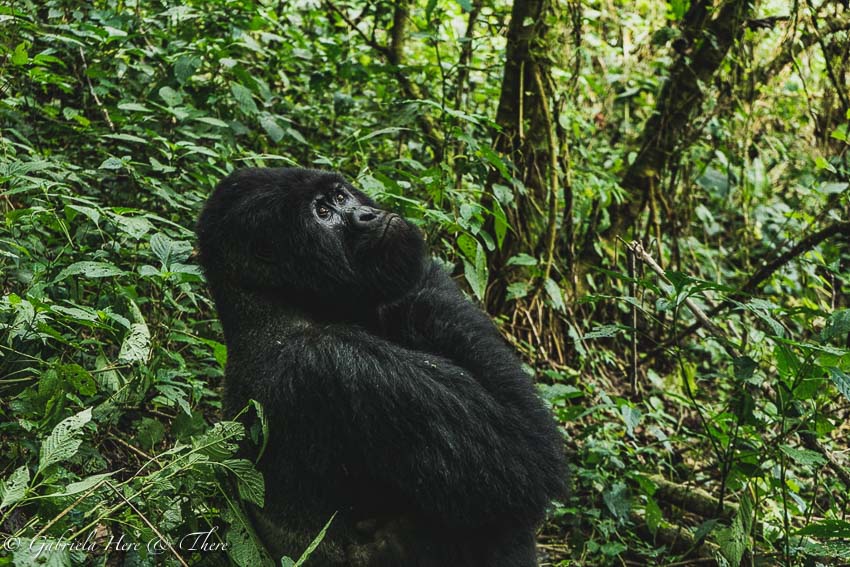
As I mentioned, you can also go gorilla trekking in Uganda or Rwanda, but here are some solid reasons why you should do it Congo:
1. The Permits Are Cheaper
In Uganda, a gorilla permit costs $800, and in Rwanda, prices recently skyrocketed to a whopping $1,500. In comparison, Congo remains the most affordable option, with permits at just $400.
2. In Congo, Your Money Makes a Bigger Impact
The Democratic Republic of Congo is much poorer and less developed than Uganda or Rwanda, and it also receives far fewer tourists. A portion of the permit fees goes directly into community projects like clean water initiatives, agricultural programs, and road improvements. Our ranger explained how tourism has already transformed local villages—giving people access to clean water and better infrastructure—and how communities now understand the value of protecting wildlife. Supporting gorilla trekking in Congo really does make a difference.
3. It’s Safer Than You Might Think
While traveling independently in the Democratic Republic of Congo can indeed be dangerous—the country is known for violent crime and rebel activity—visiting Virunga National Park is considered safe for tourists. You’re always accompanied by armed rangers who work tirelessly to protect both the gorillas and visitors. Tourists are well looked after, but it’s worth remembering that the rangers take on real risks in their work. Sadly, every year some lose their lives in confrontations with rebels or poachers.
4. The Hike Is Much Easier
I had heard plenty of stories about people in Uganda hiking for up to eight hours through dense rainforest just to see the gorillas, so I was mentally prepared for a long, exhausting trek. To my surprise, in Congo it was much easier—we only walked for about an hour through open fields before the rangers received a call that the gorillas had been located. From there, it was less than a 10-minute walk into the rainforest before we were standing face-to-face with them.
5. It’s All About the Adventure!
If you’re looking for a truly unusual and adventurous destination, the Democratic Republic of Congo should be at the top of your list. Beyond gorilla trekking, you can also take on epic volcano treks, go on chimpanzee walks, or even challenge yourself with Rwenzori mountain climbs. DR Congo is all about raw adventure and unique experiences you won’t find anywhere else.
My Gorilla Trekking Experience

Read my previous post to discover more about my travels in the Democratic Republic of Congo, including crossing the border, hiking to the world’s largest lava lake on Mount Nyiragongo, my recommended tour company (I used Green Hills Ecotours), and tips on where to stay in Goma.
After the volcano hike, I spent a night in Goma at Hotel Jerryson before heading to Bukima, the starting point for all gorilla treks. The drive there was much longer than the previous one to Mount Nyiragongo’s trailhead, taking over an hour along a very bumpy road. I was still traveling with the Austrian guy who had joined me on the Nyiragongo hike. He hadn’t originally planned on doing the gorilla trekking but changed his mind after our volcano adventure. Luckily, Innocent from Green Hills Ecotours managed to arrange everything for him at the very last minute.

When we arrived at the starting point, there were a few other trekkers—still less than ten in total—which surprised me since no one else had joined the volcano hike two days earlier. Before setting off, we all had a briefing to learn more about the gorillas, the area, and the rules for being near them. Afterwards, we were split into two groups, each assigned to visit a different gorilla family. My group had four people, plus rangers and porters, and we were heading to see the Humba family.
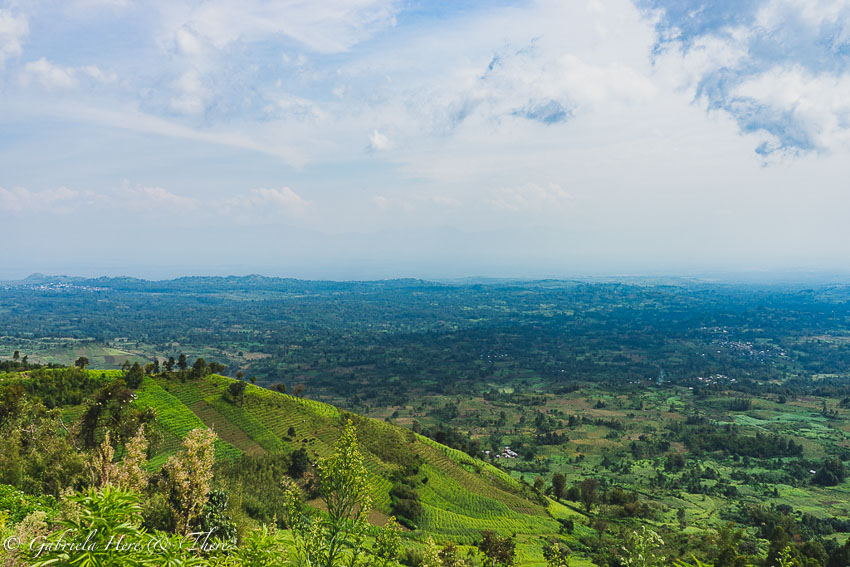

As mentioned earlier, the hike was much easier than I had expected. We walked through a field for less than an hour before our ranger got a call that the gorillas had been spotted. From there, we climbed up a hill to the rainforest, and after walking about 10 meters in the rainforest, we were told to leave our belongings there. You can only take a camera with you, and you’re given a mask you have to wear near the gorillas so that they don’t get any diseases from humans.

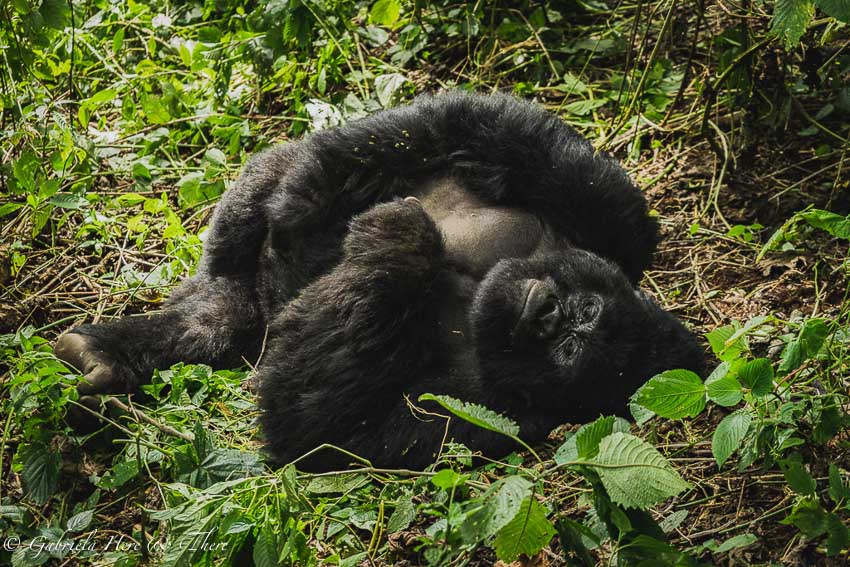
At this point, I was still confused by how easy the hike had been and could hardly believe we were already so close to the gorillas. But after walking just another 10 meters, I spotted the first one—a silverback lying on the ground. Soon after, we also saw a mother with her baby.
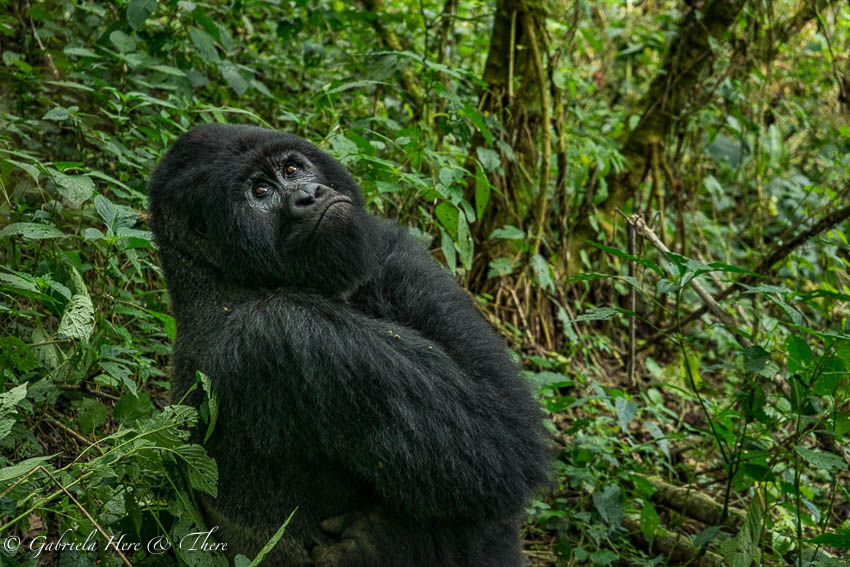
It was fascinating to watch the gorillas, especially since they didn’t seem to pay much attention to us. The rangers explained that the gorillas are accustomed to a specific group of rangers they know and trust. If unfamiliar people showed up, however, the gorillas could become aggressive—and considering their size and strength, that’s something you definitely want to avoid! We carefully followed the rangers’ instructions on where to stand and how to behave. The gorillas remained calm and relaxed, clearly used to the presence of their trusted rangers.
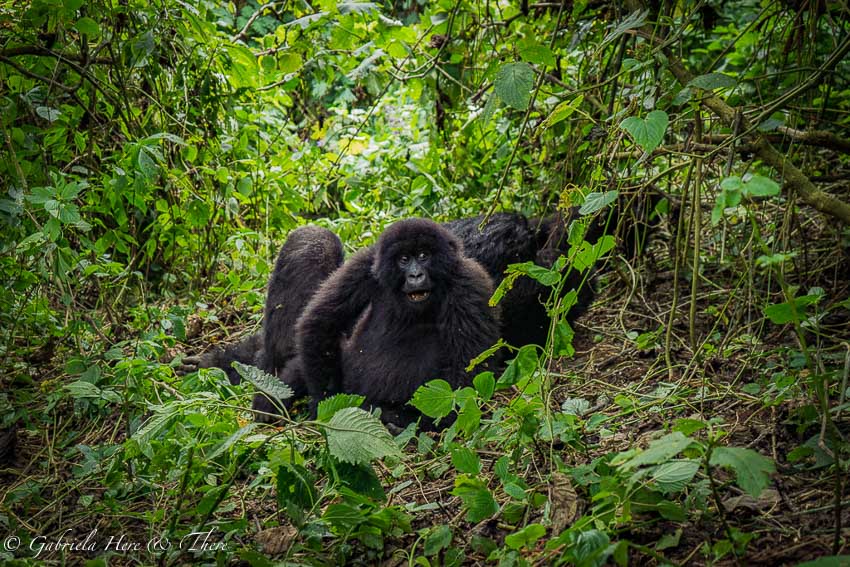
We continued deeper into the rainforest and soon encountered the rest of the gorilla family. In total, we were allowed to spend one magical hour with them before heading back. The rangers were incredibly professional and shared many fascinating stories and facts about the gorillas. Overall, it was an unforgettable experience, and I felt truly privileged to witness these endangered animals so closely in their natural habitat.

After the hike, our driver took us straight back to Goma, where I crossed the border into Rwanda. That’s when I ran into some unexpected trouble. To enter Rwanda, you need to apply for your visa online at least three days in advance. While I had applied three days earlier, I hadn’t considered that weekends don’t count—so when I tried to cross on a Sunday, my visa wasn’t ready, and I was denied entry.
For a moment, I panicked, thinking I might be stuck for several days between the two countries since I couldn’t re-enter Congo either. Thankfully, my driver contacted Green Hills Ecotours, and Ruth came to my rescue. She called the immigration office, explained the situation, and managed to get my visa approved immediately.
If you’re interested in doing gorilla trekking, check out Virunga National Park’s website and Green Hills Ecotours!
And if you are interested in doing other activities in Congo, read more about my experience climbing Mount Nyiragongo, the world’s largest lava lake.
Pin to share:



23 comments
What an experience! Some amazing photos and great tips for others… One day I hope to go with my son. Would be incredible to see these expressive creatures up close.
I hope you can go with your son! It was an incredible experience ?
Great article, I had only known about being able to do this in Uganda & Rwanda so very valuable!
Thank you!
Wow! This sounds like such an amazimg experience. I really hope I will be able to do that one day since monkeys are my favorite animals. I am still slightly scared though. Is it really that harmless?
Yes, DR Congo is not that dangerous if you just visit Virunga National Park and Goma. You also help the community and gorillas when you spend your money there ?
Wow I had no idea you could see gorillas anywhere other than Uganda and Rwanda. I’d love to do it! Interested to read your other posts to learn more about the safety of the country.
Yes, check out my Mount Nyiragongo post – it has some more information about my time in DR Congo.
Wow sounds like an amazing experience and lots of useful info here! I would love to do this some day 🙂
Thank you! You should do it – it’s the most incredible things I’ve ever done!
I’ve always wanted to go gorilla trekking but had never considered going on DRC. It sounds amazing though, and as long as the cheaper price doesn’t come at the gorillas’ expense – even better 🙂
Yes, it’s the opposite. Your money helps to protect the gorillas who in DR Congo, need more protection than the gorillas in Uganda or Rwanda.
Awww omg so pretty <3
Thanks!
Oh what an amazing experience! I have read so much about the displacement of wild gorillas due to heavy metal mining and violence in Congo, it is such a relief to read such a positive piece from you. I had not heard about trekking in this region and this is all so good. Great post and thank you for sharing.
Yes, the gorillas have been in danger in DR Congo, and they still are. The rangers work hard to protect the gorillas because there are still rebels and poachers.
This sounds totally amazing!! I wouldn’t have known that you could travel in DRC cos of the unrest but it sounds like you’re fairly well protected with the tour. Thanks for sharing!
Virunga National Park and Goma are safe to visit, other places in DR Congo might be more dangerous.
Wow Gabriela, you are so lucky to be upclose with these majestic creatures! I think I am having a Jane Goodall moment. Haha. I will definitely include Gorilla Trekking in my travel plans this year.
It was incredible to see them! I hope you’ll have a chance to go gorilla trekking too 🙂
Really happy to have come across this post. 🙂
its pretty good
I went to DRC in 2015- it’s not necessarily “easier” to see gorillas there than in Rwanda/Uganda because the gorillas move up and down the mountain. When I went, it was a 3 hour hike from Bukima Camp. Sometimes the gorillas come down into the camp itself. The hike was wonderful though.